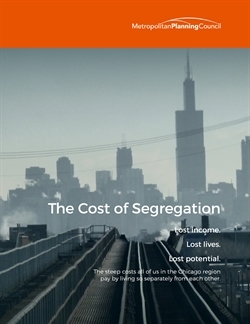Two Extremes of Residential Segregation (Part 1 of 3)
There’s a lot of talk these days about making inclusion and equity an imperative, especially as it relates to housing policy. And honestly, it’s about time.
In fact, we recently co-authored a paper for Harvard’s Joint Center for Housing Policy’s April symposium about the need to rethink strategies for desegregation in the region’s two poles: concentrated poverty and concentrated wealth.
In the first part of this three-part blog series, we introduce the current political and economic dynamics in the Chicago region that continue to perpetuate inequitable conditions and why policy change is both difficult and necessary. (You can read our more lengthy paper in its full glory here.)
Before diving into what’s possible, it’s important to talk about some of the barriers this work faces. Historically, the city’s own urban redevelopment and housing policies contributed to the siting of African-Americans in particular areas of the South and West sides, while also segmenting immigrants into neighborhoods best described as ethnic enclaves. Chicago’s development as a segregated city was largely dominated by powerful political processes. For example, housing and mortgage redlining policies kept African-American residents confined to the city of Chicago’s lower-income neighborhoods, while other policies encouraged white flight, highway expansions, and the growth of the suburbs.

Chicago’s current political and economic dynamics create conditions that make policy change both difficult and necessary. The latest findings from our Cost of Segregation study, in partnership with Urban Institute, demonstrate how residential segregation has negative effects on the social and economic outcomes of entire regions. Our findings show that while the Chicago region has decreased its economic, black-white and Latino-white segregation by 10-11 percent between 1990 and 2010, such modest gains are far from sufficient.
At our current pace, the region would not reach the median level of segregation of the nation’s largest 100 regions until 2070. What then can we achieve within our lifetimes? If we can’t reach the median by 2030, could we at least cut the distance in half by then through deliberate, facilitated intervention? Growing income inequality in Chicago along with its enduring spatial segregation require creative policy solutions, unprecedented levels of political courage and will, and the willingness to reallocate resources even in times of fiscal challenge for the city, region and state.
We see reasons for optimism and hope for change: In 2016 the city of Chicago enacted the Neighborhood Opportunity Fund, which extracts fees for density in booming areas of the city and redirects the bulk of the dollars to commercial corridors in struggling markets. In March 2017 the Department of Planning and Development released a draft framework for reviewing requests for city investment in affordable housing that, for the first time, conveys the expectation of units in markets across the entire city. In 2013, Cook County amended its Human Rights Ordinance to make landlord discrimination against Housing Choice Voucher holders illegal. There is a new level of urgency in addressing our disparities that make us hopeful.
We must address concentrated poverty and concentrated wealth in the Chicago region.
Of course, a new level of political will and economic resources is necessary to achieve a more integrated and equitable Chicago. In this series, we argue that a movement is needed to rethink strategies for desegregation in the region’s two poles: concentrated poverty and concentrated wealth. We focus there not because the areas between the poles are unimportant (in fact, we’re working on policies for middle markets as well), but because we recognize two factors: inclusion in these “middle” areas may be less challenging than in the extremes, and increasingly, the bulk of the region’s real estate is habitated not by the middle class but by either the impoverished or the affluent (see this post for a map of this shift at the city level). In exploring new policies for these two poles, we share our reflections about how to move the Chicago region decisively toward desegregation by race and income.
Read Part 2 and Part 3 of this series.